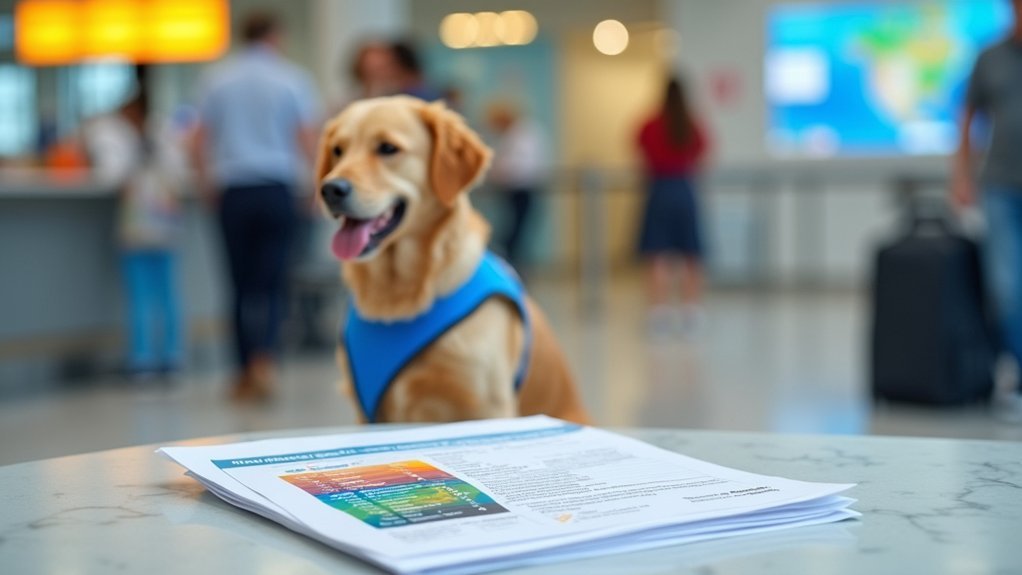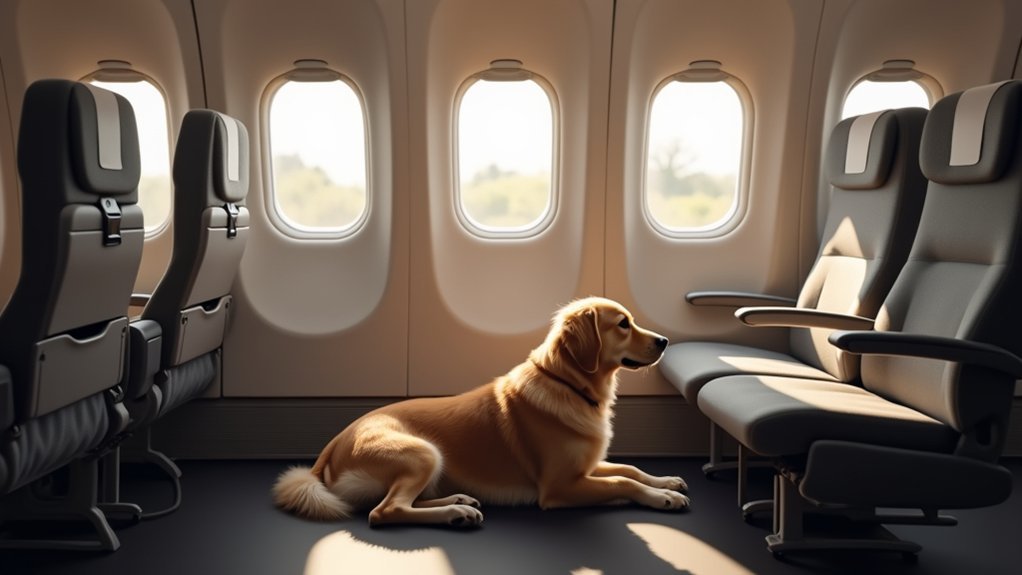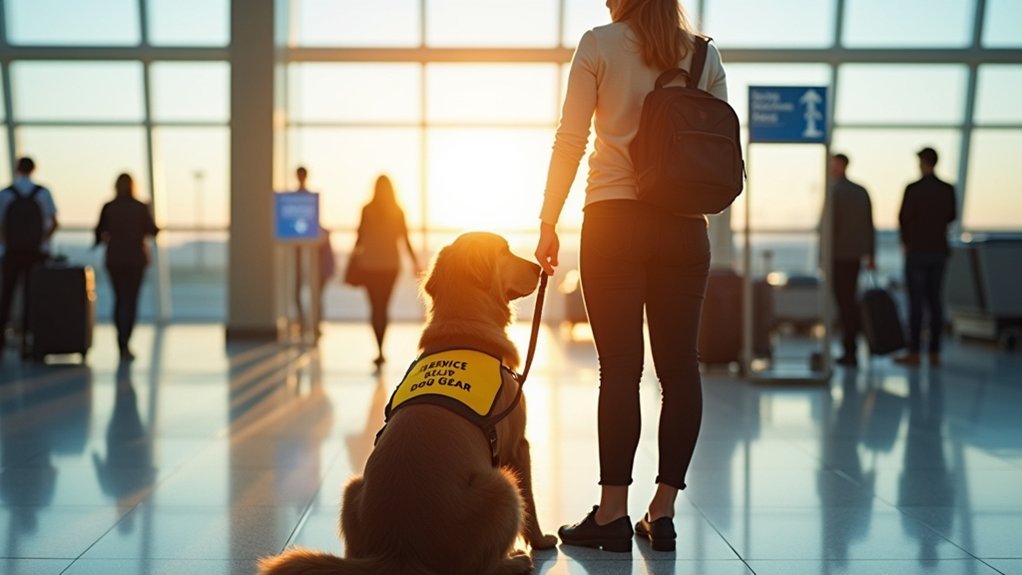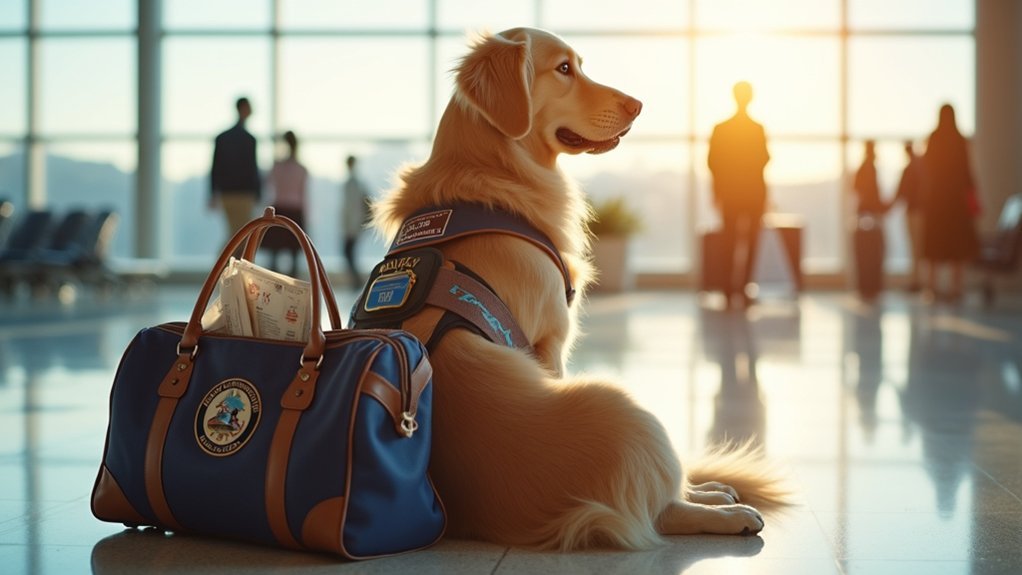When traveling internationally with your service dog, you’ll need health certificates, rabies documentation, and USDA verification – all notarized. Contact your airline at least 48 hours ahead with required forms. Confirm your dog fits in your foot space or lap during flights. Research destination country requirements early as they vary widely. Train your dog to handle airport stress, crowds, and long flights. These five guidelines will help confirm smooth passage through customs and comfortable journeys.
Essential Health Documentation and Vaccination Requirements

Three critical health documents form the foundation of international service dog travel. Your service dog needs a health certificate, rabies certificate, and good health letter from your veterinarian—all notarized and certified by the USDA.
Many countries also require microchip documentation for identification purposes.
Ensure your dog’s vaccinations meet destination requirements, particularly rabies shots administered at least 15 days before travel. Some countries accept 3-year rabies vaccinations from the US, while others have specific timing requirements. Rabies vaccinations must be completed at least 28 days before international travel.
Depending on your destination, additional treatments like deworming may be necessary.
Prepare all documents in the destination country’s official language. Always carry both original documents and copies when traveling internationally.
Contact the country’s embassy and agricultural ministry to verify specific requirements before departure.
Pre-Flight Preparation and Airline-Specific Regulations
Preparing your service dog for international flights demands thorough planning and careful attention to airline regulations well before your departure date.
Most airlines require advance notification and submission of specific documentation for service dogs. You’ll need to complete DOT service animal forms, typically 48 hours before your flight.
Some carriers have additional customized forms beyond these requirements. Remember that while airlines verify these forms, they can’t deny your service dog based on breed.
Be aware that only trained service dogs—not emotional support animals—are guaranteed cabin access. Your seating arrangements may need adjustment based on your dog’s size.
Each airline has slightly different policies, so contact your carrier directly to understand their specific requirements and verify necessary submission timeframes for all documentation. When traveling to countries like India, Hong Kong, Japan, or Guyana, you must comply with specific country requirements that may include special permits, certificates, or advance notifications.
Managing Cabin Space and Seating Arrangements

When traveling internationally with your service dog, understanding cabin space restrictions and seating options is essential for a comfortable journey. Your service dog must fit within your foot space or on your lap without encroaching on other passengers’ areas.
While airlines don’t impose strict weight limits, they require that your dog doesn’t occupy a separate seat unless you’ve purchased one. For larger service dogs, request a window or aisle seat with adequate floor space during booking. Airlines may offer alternate seating arrangements within your service class to accommodate larger animals.
If you’re traveling with particularly large breeds or multiple service dogs, contact the airline in advance. DOT regulations allow up to two service dogs per passenger. Remember, your service dog can’t block aisles or emergency exits.
Airlines must either accommodate your dog in-cabin, transport it in cargo free of charge, or rebook you on a later flight.
Meeting Destination Country Entry Protocols
Each country maintains unique requirements for service dogs entering their borders, making advance preparation essential for international travel.
You’ll need to obtain country-specific health certificates within the required timeframe, typically 10 days to a few months before departure.
Ensure your service dog has current rabies vaccination documentation, and be prepared for additional requirements like rabies titer tests, parasite treatments, and ISO-compliant microchipping.
Many countries require advance notification and may impose quarantine periods or entry inspections.
Carry all original documentation, including proof of service animal training and any required entry forms.
Contact the destination country’s embassy early in your planning process to verify current requirements, as regulations can change.
Failure to meet these protocols could result in denied entry or mandatory quarantine.
Only service dog teams trained and certified by ADI Accredited Member organizations may have guaranteed access in many international destinations.
Training Your Service Dog for International Travel Environments

Beyond meeting entry requirements, your service dog’s ability to handle the challenges of international travel environments directly impacts your journey’s success. Training should focus on both ADI standards (minimum six-month training period) and environmental adaptations specific to international settings.
| Training Focus | Challenge | Solution |
|---|---|---|
| Noise tolerance | Airport/airplane noise | Gradual desensitization |
| Bladder control | 8-12 hour flights | Extended holding practice |
| Public behavior | Crowded terminals | Regular exposure training |
| Stress management | Security checks | Simulation exercises |
| Climate adaptation | Temperature changes | Varied environment exposure |
Prioritize continuous training that reinforces calm behavior in stressful situations. Your dog should respond to visual cues when verbal commands aren’t practical. Remember that foreign regulations vary significantly from U.S. protections, requiring additional preparation for your service dog team. For international travel success, implement pre-travel preparation by gradually increasing exposure to travel stimuli that mimic your destination’s environment.
Frequently Asked Questions
Can Service Dogs Use Airport Pet Relief Areas During Layovers?
Yes, your service dog can use airport pet relief areas during layovers. They’re also allowed access to specially designed Service Animal Relief Areas (SARAs), where they have priority over pets for their needs.
Will My Service Dog’s Medication Require Special Customs Documentation?
Yes, your service dog’s medication will require customs documentation from a veterinarian. You’ll need to check destination country regulations, guarantee original packaging, proper labeling, and carry only necessary quantities for your trip.
Are There Specific Feeding Guidelines Before International Flights?
You’ll want to feed your service dog several hours before flying to avoid digestive issues. Don’t feed them right before takeoff, and make certain they’ve relieved themselves before boarding for maximum comfort.
What Happens if My Service Dog Becomes Ill Abroad?
If your service dog becomes ill abroad, you’ll need to find a local veterinarian, carry proper documentation for treatment, and possibly adjust your travel plans. Always maintain insurance coverage for unexpected medical costs.
Are Retired Service Dogs Subject to Different Travel Requirements?
Yes, your retired service dog will typically be classified as a pet for travel purposes. You’ll need to follow standard pet travel requirements, including carrier restrictions and possibly additional fees when traveling internationally.
In Summary
You’ll face unique challenges when traveling internationally with your service dog, but proper preparation guarantees a smoother journey. Remember to secure all documentation, understand airline policies, plan for limited space, research destination requirements, and prepare your dog for unfamiliar environments. With these five rules, you’re well-equipped to navigate global travel while maintaining your service dog’s effectiveness and your peace of mind.





Leave a Reply